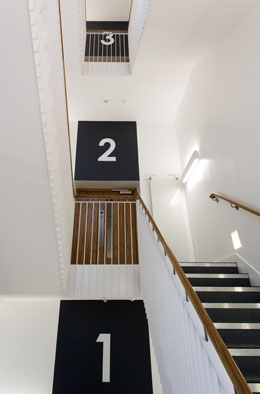University awarded top green honour
An ambitious new state-of-the-art lab at the University of St Andrews has been rated the most environmentally-friendly in the country.
The cutting-edge University building – home to research into microbial infection and human immunity – has been recognised for its ability to divert savings on building and energy costs into vital research.
The top green rating, given to the University’s Biomedical Sciences Research Complex (BSRC) Annex, makes it the first laboratory in the UK, and the only building in Scotland, to receive such an award. The ‘Outstanding’ rating awarded by BREEAM – the world’s foremost environmental assessment method and rating system for buildings – is only given to buildings around the world given a sustainability score of over 85%.

The accolade pays tribute to the University’s design team who set themselves the challenge of delivering a building with a world-beating environmental performance for less money than a conventional building. The £13m lab, a flagship investment in the University’s ambitious research programme, is already making an impact with high profile discoveries into how vital DNA repair mechanisms have evolved, and in the development of new drugs.
Professor James Naismith, Director of BSRC, said, “The project is a model for what can be done and demonstrates the University’s ambition for both world leading medical science and environmental performance. The fact that the money saved on construction and on the reduced running costs would go directly to fighting human disease was a powerful motivator for us all.
“Due to the nature of the work carried out in them, laboratory buildings are often energy intensive in construction and operation. In the first nine months of operation however, our building is costing less to heat, light and power than predicted, and has beaten every environmental target we set for it.
“This award recognises the scientists, the University professionals, the design team, (BMJ architects, Turner Townsend, DI Burchell and RSP engineering), and the construction company, Sir Robert McAlpine, who worked together to make the vision a reality.”
The building, which became operational in January this year, was funded by in part by a £5m grant by the Wellcome Trust, the largest single capital award made to the University in its 600 year history. Aiming to make a difference to human health by tackling some of the most serious health problems faced by man, the University invested a further £8m of its own resources to make the concept a reality.
Uniquely, the BSRC is a cross disciplinary endeavour with scientists from the Schools of Medicine, Biology, Chemistry and Physics working side by side.
Speaking on behalf of the University’s Estates Department, Mr Mark Simpson said, “The University takes its environmental commitments very seriously. We recognised that with this building there was a real opportunity to do something special and we are delighted to have achieved just that. This latest award for the building, confirms the University of St Andrews at the cutting edge of innovation in developing a sustainable, functional and pleasant physical estate.”
Dr John Smith, the University’s Science Buildings Manager, who worked closely on the project from day one, added, “My science background and experience in managing buildings meant my job was to make sure we stayed on the same page. What is so exciting is that the building makes no compromise in usability for the scientists, whilst delivering this outstanding environmental performance.”
The BREEAM (Building Research Establishment Environmental Assessment Method) certification is designed to identify sustainable buildings by assessing their design, construction and operation. Since its launch in 1990 over 200,000 buildings around the world have been rated and a million submitted for assessment.
The new building was designed from the beginning with sustainability in mind – from exceptional insulation and a highly efficient heating system to enhancing local wildlife habitats, the lab has many hidden design features that reflect the talents and commitment of the entire design team. Sir Robert McAlpine had to develop entirely new ways of working, sourcing materials and recycling waste to meet the required standards. Crucially the outstanding performance came with no additional cost to build and no delays in delivery.
Welcoming the news, the University’s Principal and Vice-Chancellor Professor Louise Richardson, commented, “We are very proud of this building, of the cutting edge research it enables, and the commitment to the environment it demonstrates.”

ENDS
Issued by the Press Office
Contact Gayle Cook, Senior Communications Manager on Tel: +44 1334 467227, Mobile: 07900 050 103, email: [email protected]
Follow St Andrews news on Twitter
Like on Facebook
Ref: BREEAM 171012
Category University news